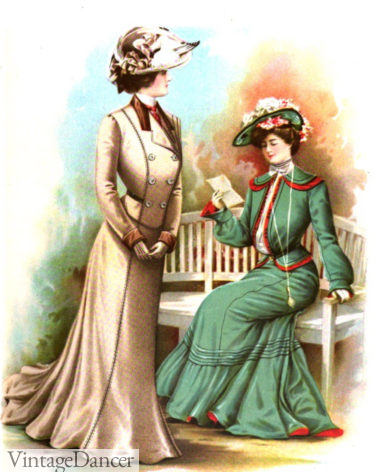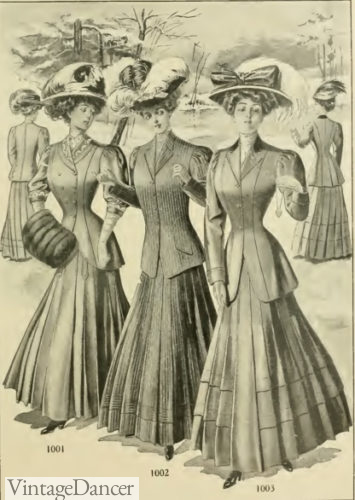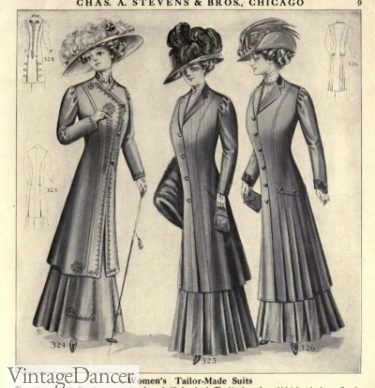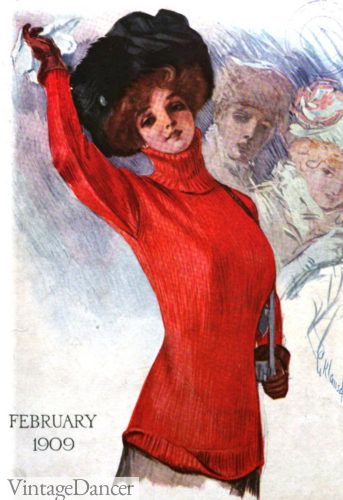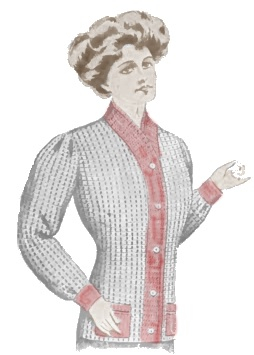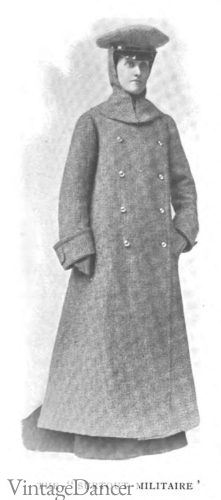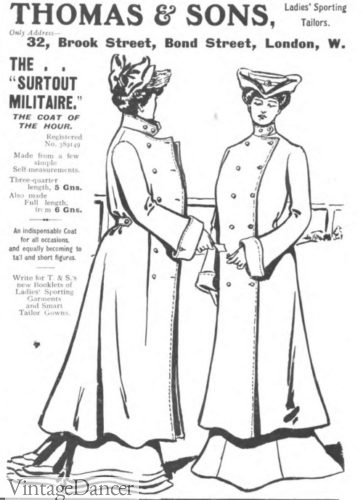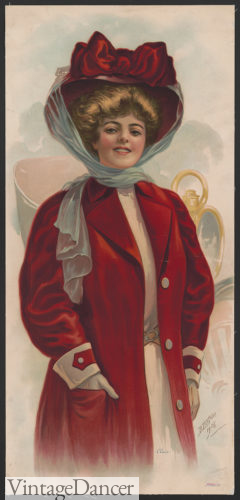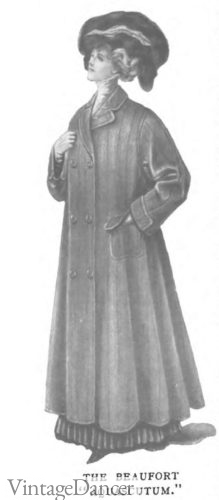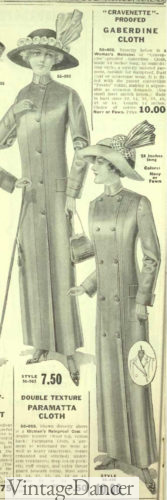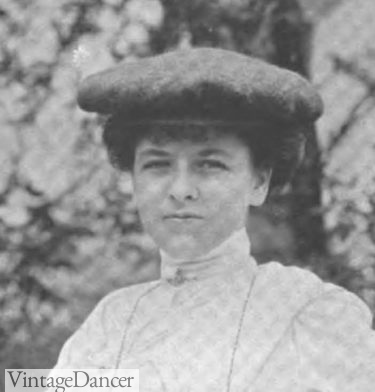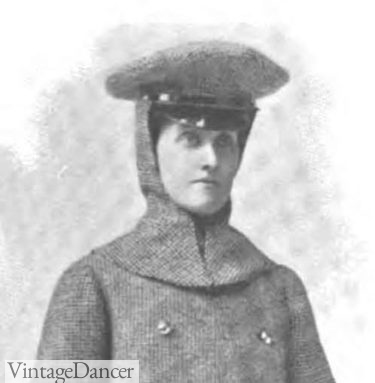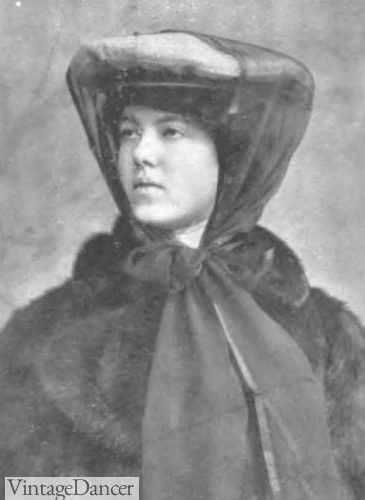The Bay Area Horseless Carriage Club reached out to me about giving a digital presentation of Edwardian era (aprox. 1900-1914) motoring clothing for women and men. What an interesting topic! With the introduction of travel by automobile, “motoring” to a friend’s house or across the country became a hobby for many adventurous women who were not satisfied with being shuttled around by chauffeurs or spouses. They took to the wheel (or stick for earlier models) and drove themselves wherever they pleased, stopping to make their own repairs along the way.
Emily Post, the great social etiquette advisor, was a frequent motorist with her husband, her son, or on her own. Other famous women followed. Owning an automobile was not an inexpensive hobby, so many of the Edwardian era motorists were wealthy enough to afford a dedicated set of motoring clothes and accessories.
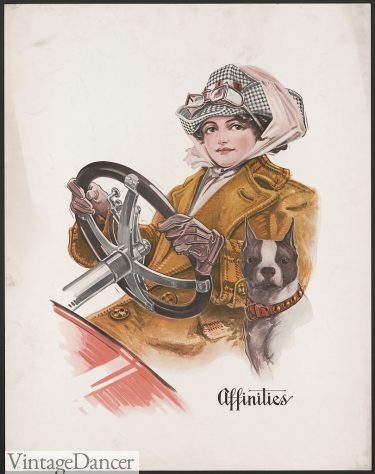
With unpaved roads, open tops, and unpredictable weather, women had to dress for motoring in protective clothing. This included long coats for every season, gloves, shoes, hats, scarves, and goggles. By the time a woman reached her destination, she was a dusty, mud splattered mess! Etiquette called for a woman to never appear this way in public, so she often stopped just short of her destination to remove her outerwear, change hats, shoes, and scarves, and drive in like a beautiful Gibson girl.
While researching for this article, I found quite a few original sources from specialty car magazines and travel books from the USA and UK, including one dedicated to women motorists: The Woman and the Car, written by Dorothy Levitt in 1909. In it she advises women to wear the following:
- Suit: A two piece skirt and jacket set. An extra sweater for warmth with…
- Blouse: A button down shirtwaist, very simple.
- Dress: A simple dress to match your destination (party, tea, vacation, etc).
- Underwear: Petticoat and slip.
- Smock: Optional driving smock.
- Coat or duster: A long roomy fur coat in winter, tweed lined in mild seasons, or a light cotton or linen coat in summer.
- Shoes: Flexible leather sole pumps, slippers, or boots if not too restrictive. Gaiters to the knee.
- Hat: A flat top beret, turban, sailor cap, or fur cap, with motoring scarf wrapped around hat and head.
- Goggles: A pair of driving goggles.
- Scarf: A neck scarf for warmth.
- Gloves: Soft leather gauntlet gloves year round. Fur mittens for winter.
Through exploring each of these requirements, we learn that function was very important but fashion was never far behind. Motoring coats and hats changed with the fashion trends just as often as dress clothes did. Women had to travel light, so making intelligent choices about her clothing was critical.
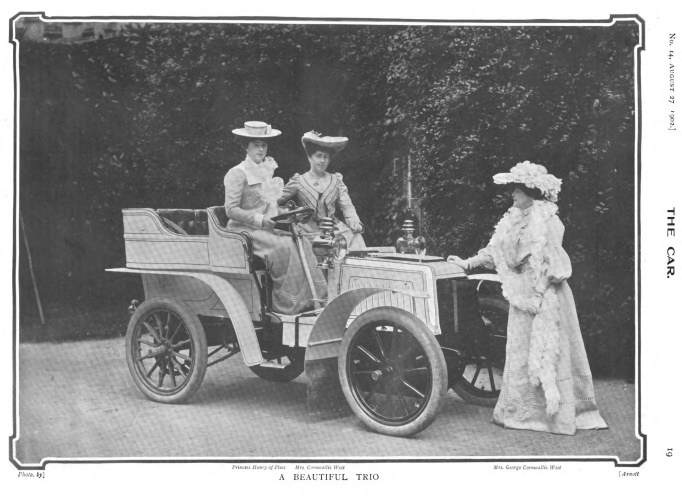
1902 three women motorists who never dressed like this while driving a car, only for photos
Edwardian Suits
An independent woman of the Edwardian era embraced the suit as her daily uniform. They were durable, practical, and empowering – the perfect outfit for traveling in cars. The suit consisted of a long skirt, a matching jacket, and a separate blouse. Each piece could also be not matching. In the below case, the skirt was patterned and the jacket was solid. Common fabrics were blue wool serge or brown or grey tweed in winter and white/cream serge or moire in summer.
Belts were often added with separates to define the waist. They could be thin or wide, simple or ornate, and were made of leather, velvet, or knit material.
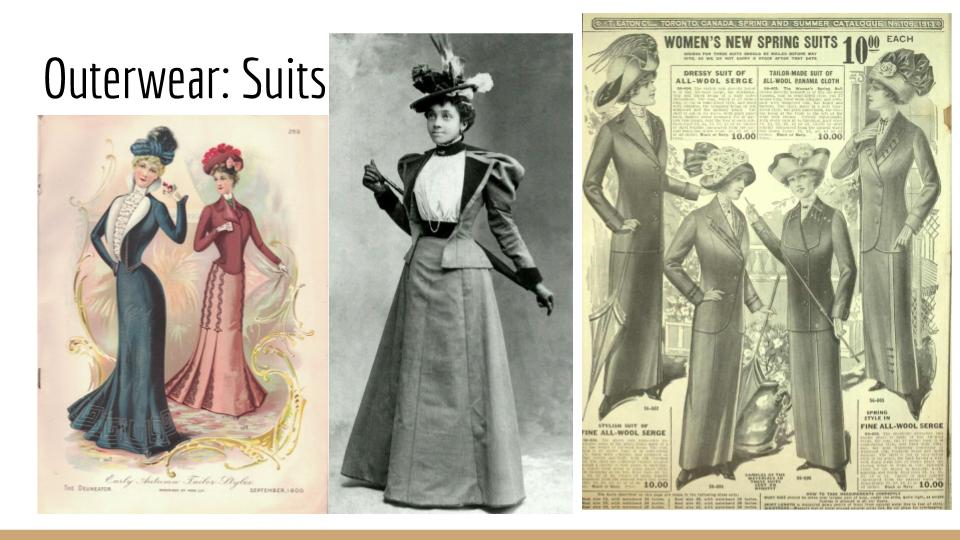
Suits: Left – 1900, Middle-unknown, about 1905 , Right- 1912
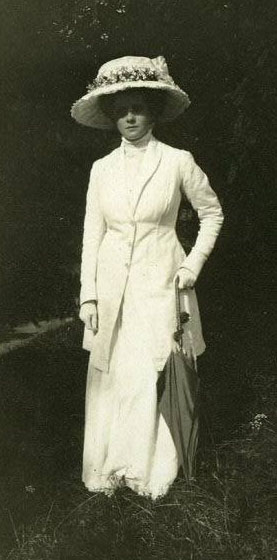
About 1910, a white summer suit
The skirt changed in shape from 1900 to 1915 a few times. Initially, the 1890s shape was A-line with a full flared hemline. Then in 1900, it moved to a more fitted and lean “bell” shape with a full hem at the bottom third only. Then it moved back to a very full A-line shape. After 1910, it went back to a straight up and down “hobble skirt,” although most women continued to wear more practical, less restrictive straight skirts.
The year you want to reproduce and your outfit will determine the shape of the skirt. For motoring, a loose skirt with more fullness (pleated), not less, will be the most practical for driving. An ankle length will also be the best hem, even though fashionable styles stated hemlines should be closer to the floor.
Shop Edwardian skirts and belts.
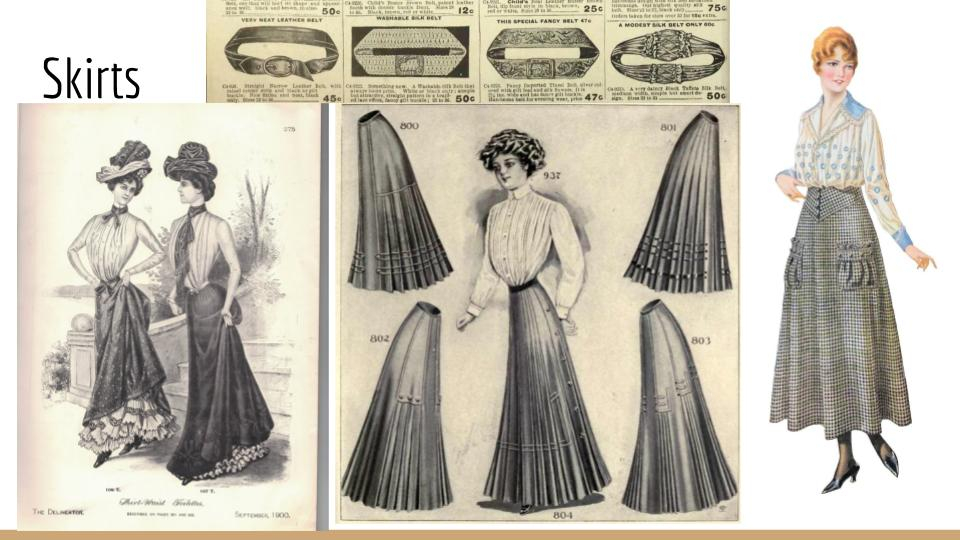
Edwardian skirts and belts :Left – 1900, Middle and belts- 1909, Right- 1915
The blouse was a very modest, high neck, white or colored top called “waists.” Most blouses buttoned in the back at the turn of the century, but more and more front buttoning options were in style as the decade moved on. The front buttons added some decoration and a more masculine look for suit wearing ladies.
They had a high collar and wide cuffs with pleats, lace, or ruffles down the front. One motorist advised avoiding any blouses with big ruffles or trim that would flap in the wind. Pleated fronts were the best at hiding wrinkles. They should be pleated or smooth on the front with a snug collar and ample arm space. For blouses with a more open neckline, a detachable dickey could be worn underneath. Shop blouses.
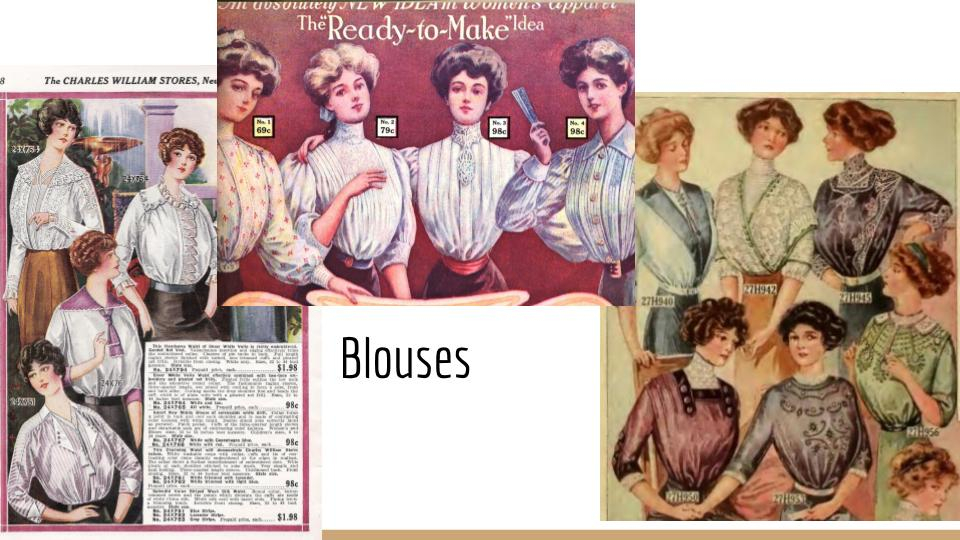
Blouses: Left – 1914, Middle – 1906, Right- 1912
Jackets
A matching suit jacket was sold with the suit skirt as a set. A separate non-matching jacket could also be worn with a skirt and blouse. These waist length jackets were tailored to fit snugly at the waist, with fuller shoulders and usually some kind of large collar that was faced in a contrasting material. They buttoned up high with single or double breasted buttons. After 1920, suit jackets were less fussy and more streamlined, without large collars or decoration. They also lengthened as the decades progressed moving down to hip level and then nearly to the hemline with more coat-like jackets.
- 1902 suits with short jackets
- 1907 suits with mid length jackets
- 1909 suits with long jackets
For an extra layer of warmth, motorists would wear a knit sweater or sweater vest underneath or in lieu of a suit jacket. Sweaters could be in pullover or cardigan style, in bright colors and sometimes contrasting edges. They featured a heavy knit pattern, not smooth like more modern sweaters. These seemed far more practical to wear while driving than a tailored jacket, though they were less fashionable. Shop sweaters.
- 1909 pullover sweater with turtle neck collar
- 1909 cardigan sweater
Dresses
Instead of separates, many women chose to wear a one piece dress. The type of dress fit the final destination. If going to a summer tea party, a woman would wear her fine white summer frock. If she were going to the beach on vacation, she might wear a sporty sailor dress. For all day travel, her dress would be simple yet presentable to wear in the hotel lobby. Keeping up appearances was very important to the upper class ladies who owned cars. It also determined how well she was treated at each of her stops. Dirty and “poor” looking meant she was ignored. Looking luxury? That led to first class treatment.
For dresses that could be easily driven in, avoid ballgowns and fancy dinner dresses with trains and low necklines. Avoid house dresses, too, as they were never worn outside of the home. A solid color dress with a dark shade might repel the most dirt. Keep delicate trim up top only, and always under a coat for protection. Avoid fabrics that wrinkle badly.
If you look at photos of ladies sitting in cars, most are very elaborately dressed. These are staged “glamour” shots. No woman would actually drive in those outfits. She might ride in the back going short distances like to a party, but never to drive herself in. They were far too impractical for the dust and wind factors of early automobiles.
Shop Edwardian dresses and suits.
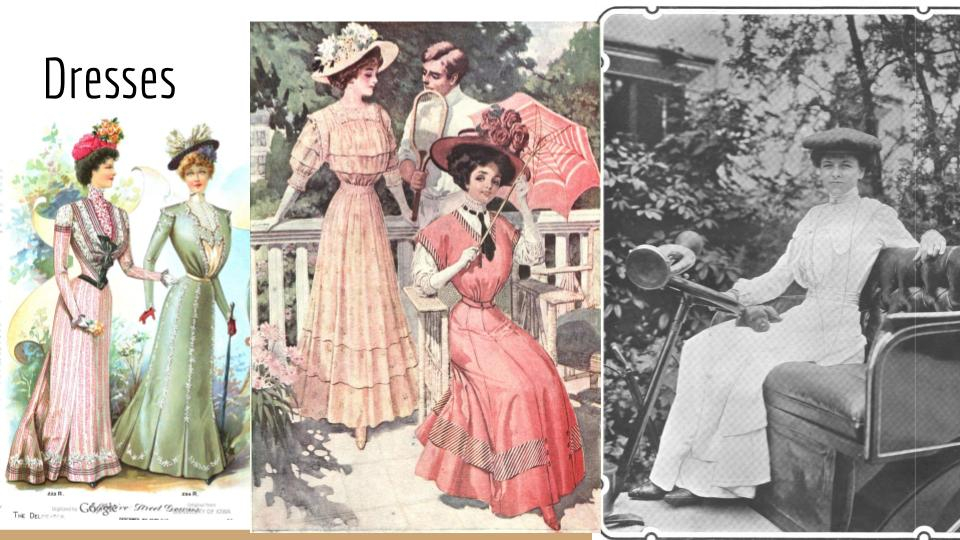
Dresses: Left – 1914, Middle – 1906, Right- 1912
Underwear
The Edwardian woman was dressed in a minimum of 6 layers of undergarments (down from 16 of the Victorian era). These undergarments were both practical and critical to creating the silhouette of the times. From inside out these layers were: Stockings, bloomers, chemise, corset, corset cover, petticoat, and/or full slip. Each garment was designed to be worn under dresses or suits with minimal bulk up top, but a full petticoat for the skirt on the bottom.
Investing in these pieces require some custom work, especially the corset. Most beginner reenactors will not wear period correct undergarments and even the more advanced person may mix historically accurate and modern pieces together.
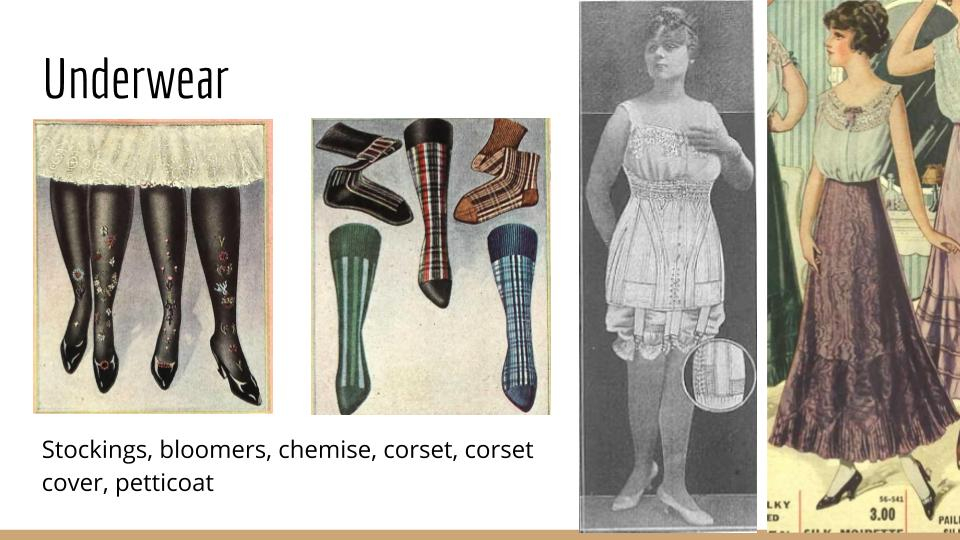
Undergarments: Left-Stockings, Middle- corset over a chemise and bloomers, Right-petticoat over a chemise/corset cover
- Petticoat: The most critical piece is the petticoat. ALWAYS ALWAYS ALWAYS wear a proper petticoat or two under your skirt or dress. It is critical to keeping the shape, as well as more comfort while driving. The petticoat keeps the outer skirt from sliding between the legs. It may hide the view of your feet a bit, which will take a little getting used to.
- Stockings: Ladies’ stockings were wool or cotton knit thigh high stockings held up with garters. Black was the most practical color, but they also came in fun colors and patterns. Since these are not visible, feel free to wear tights or tall socks instead.
- Bloomers: The panties of the day were split drawers (for easy restroom use). Knee length thin cotton with lace and ruffle around the legs acted as another petticoat. I like to wear real bloomers if I don’t wear tights because the long legs prevent the dreaded “chub rub.” A modern equivalent are bike shorts/yoga shorts or a long leg body-shaper.
- Chemise: A slip-like layer worn over the body before putting the corset on. A thin tank top works just as well.
- Corset: The myth has it that corsets are uncomfortable. They can be very comfortable when made for your body. Cheaper ready-made costume corsets are not comfortable. The design of the corset also matters. Underbust style with a short torso will be easier to drive in than the longer over-the-hip style that was more common in the Edwardian era. A good corset is a worthy investment, just make sure you can sit well in it. Modern bras do not make the corset silhouette, but we have to work with them. Wear your best uplifting bra to create the desired ample bosom for the early years or a flattening sports bra for the later years.
- Corset cover: This is yet another full slip or top-only slip worn over the corset to protect the blouse from the corset boning rubbing. It also adds a modest layer between the skin and blouse, which is important if you wear a white blouse. A round neck tank top or camisole is a fine modern substitute.
A final tip when picking out a new outfit is to start with all the undergarments on and then take your measurements. You may notice a few inches difference in the waist and bust area. Also always put your stockings and shoes on before your corset or the rest of your out outfit. Trust me!
Shop Edwardian lingerie and stockings.
Smock
Moving back to outerwear, we reach the first piece of clothing unique to motoring. The Overall, Apron, or Smock was a loose covering worn over the entire outfit except the coat. It fit like an artist’s smock or full sleeved apron with ties at the back of the neck and waist, and had a full length. It was usually a tan, blue, or brown in a water resistant fabric. A light button-front overcoat could also be used instead of a smock.
This is not something easily found ready-to buy, but can be made fairly easily.
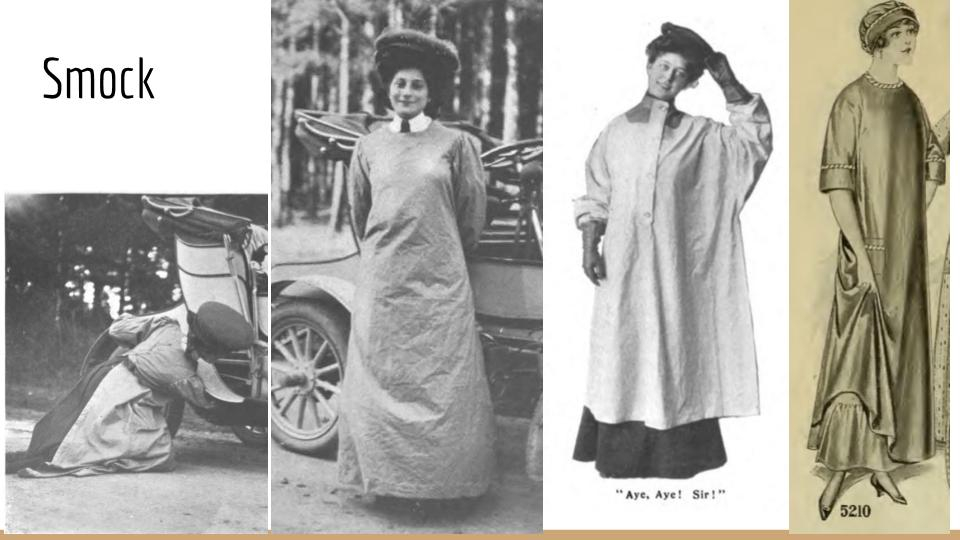
(Left) The motoring smock, middle – slip over light coat, Left- house smock
Coat
The motoring coat was the final layer to the outfit. Clothing companies jumped at the chance to sell rich motoring women the latest and greatest designs in motoring coats. Depending on the weather and personal preference, the styles of coat to consider are:
- Fur coat: Full length, long sleeve, high neck. Fur should be a dark short fur. They are extremely heavy, but very warm.
- Leather coat: Designers made all leather full length coats for motoring. They somewhat repelled water and were lighter than fur coats, but most reviews said women found them too stiff to wear on long journeys and to heavy when wet from a passing storm.
- Fabric coat: Frieze, gabardine, and tweed-lined Jaeger seemed to be the most recommended for coats when motoring in moderate or cold weather. They could be lined with warmer fabrics or lightly lined for summer.
- Dusters: In summer, a light overcoat made of gabardine, twill, or serge called a duster was worn in place of a smock. Taffeta dusters were pretty, but not dust proof. This is what most illustrations of women drivers are wearing. Practical colors were tan, off white, and blue, but bright colors like red, yellow, and purple were cheerful alternatives. The duster fit loosely enough to be worn over outfits but was more tailored, like a coat, with wide sleeves, big cuffs, deep pockets, and a wide collar that could be folded over and buttoned close to the neck. The front buttoned down in a single or double row of large buttons. Avoid linen or silk coats because they wrinkle badly.
- Rain coats were made in the same shape as the duster, but in a waterproof tight twill or rubberized twill cloth.
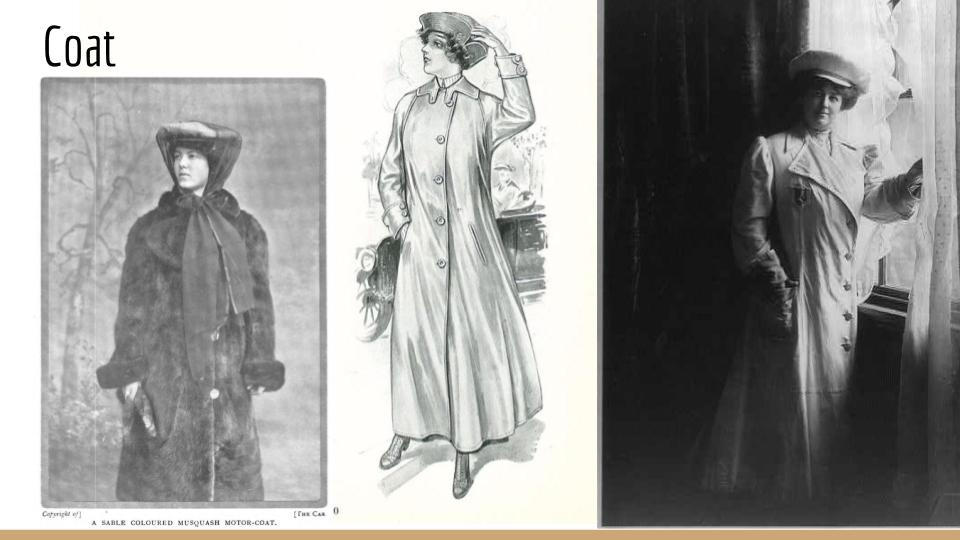
Motoring coats: Left- sable colored muskrat fur coat, Middle – leather coat, Right- clothing duster coat
- 1902 wool driving coat
- 1902 double breasted “military” style driving coats
- 1909 red duster
- 1910 Burberry coat
- 1910 plaid motoring coat
- 1913 rain coats
Shoes
As far as footwear, the typical everyday shoe was a lace up boot (later button up boots) in black or brown leather. These were fine for driving, although they could feel too restrictive on a long drive. Boots with a twill cloth top were more flexible and breathable in summer. Low heels were preferred over higher 2+ inch heels.
One motorist said she preferred to wear velvet slip-on pumps while on long drives. House slippers could also be worn while driving, but were never worn “in town.” The slipper could have a single strap like a Mary Jane shoes or none, like an evening pump. In the 1910s, the lace up or button up Oxford heel shoe was the newest style of footwear that seemed like a great compromise between boot and slipper.
For extra warmth, women could top their boots and shoes with wool, felt, or corduroy spats or knit or jersey leggings.
Shop Edwardian style hats, shoes, and spats.
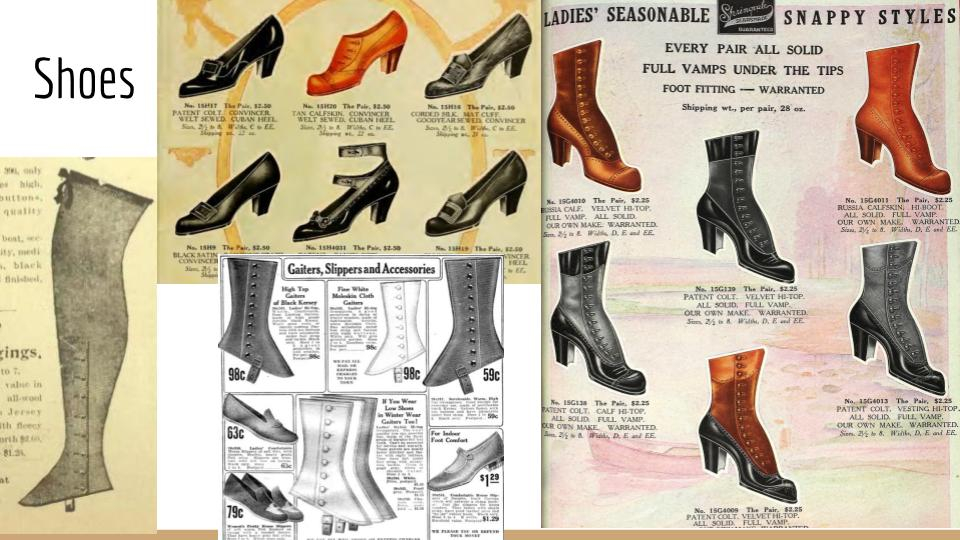
Boots and shoes. Left- 1900 knit leggings, Middle top- 1912 pumps and oxford shoes, Middle Bottom- 1917 house slippers and gaiters, Right – 1911 button up boots
Hats and Scarves
A woman motorist had a bit of an issue with Edwardian hats. The fashion of the decade was to wear very large, heavily decorated hats perched on top of very full and fluffy hair. One or two hats pins held the hat securely to the head under normal conditions, but a bit of wind could knock them right off. These were not good choices for motoring. Fortunately, some other, more casual styles of hats were adopted by motorists.
- Cap of fur: The best choice for winter has a round fur cap. Fur hats with a wider brim but low crown were another option.
- Visor caps: These flat pancakes looked like men’s golf caps, but were wide enough to circle a woman’s hairdo. Sometimes they came with attached ear flaps or a scarf to tie under the chin.
- Bonnet: A driving bonnet was one the first unique hats that was a shower cap style of hat worn over only hair or a very small hat. They looked funny.
- Tam O’ Shanter: This hat was another good winter hat that fit like a bonnet, but was knitted of soft and warm yarn.
- Tri-corn or bi-corn hat: A low profile hat with minimal decoration. Also very masculine, it fit well with the motoring aesthetic.
- Sailor hat: A straw boater hat or sailor hat was an excellent choice for summertime with short drives. The crown was low and the bride was wide but stiff. A sailor “yacht” style cap was a soft, flat, sporty summer hat with a small brim and wide body.
- Other trendy hats: Almost any hat without a brim, a low crown, and minimal decoration could be worn while motoring. Wind resistance was the key to choosing a hat.
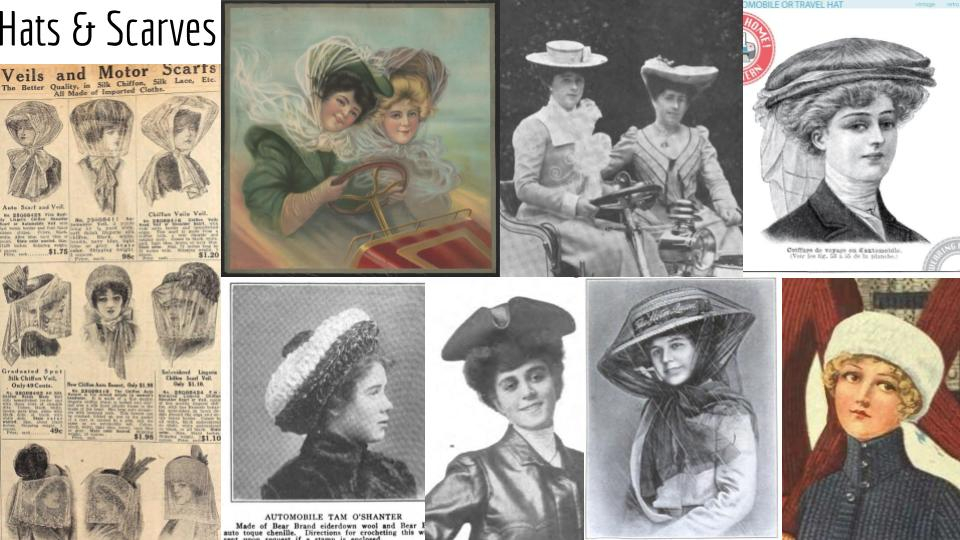
Motoring hats and scarves
- 1902 brimless driving cap
- 1902 Brim cap with hood
- 1904 sailor hat with scarf
A veil became useful, both to secure hats onto the head and to protect the face and eyes from dust. A short veil hanging down to the shoulders was fine for a casual drive, but real motoring required a much longer sheer crepe de chine scarf to be wrapped over the hat, under the chin, and around to the back or in a bow to one side.
Motoring scarves could be any number of colors. Black was dust repellent but difficult to see through. White was better for vision, but more prone to looking like a rag after an hour on the road. Orange scarves, like orange tinted goggles, seem to do to best to reduce glare from the sun. Naturally, scarves came in an assortment of colors to match outfits.
Lace or patterned scarves looked very pretty, but were not good for vision. Many women would change their hat scarf at their destination into one of the prettier shades or patterns.
A scarf should be 4-6 feet long and 2 feet wide to cover the entire hat/head with enough length to tie in a bow. The trick to keeping the slippery fabric from un-knotting is to twist the fabric a few turns before knotting it. If goggles are worn or the roads are clean, the scarf does not need to cover the face.
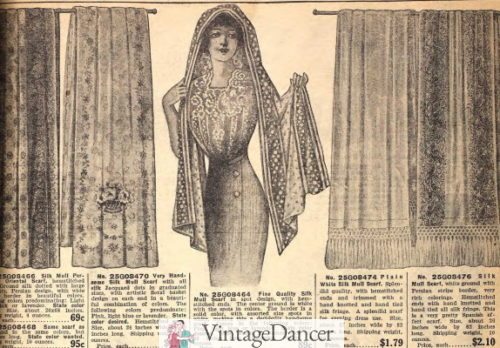
1911 these pretty pattern silk scarves were best for passengers or as fashion, not function.
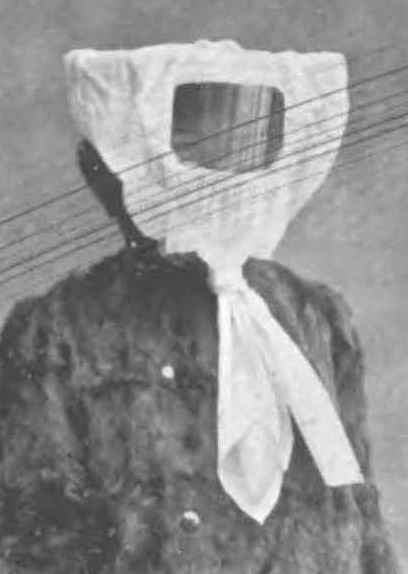
1904 a veil with a clear face mask was a good idea that was a failure when the mask fogged up
Goggles, Neck Scarf, Gloves
A few more optional accessories might be needed to complete the motoring outfit.
- A neck scarf/muffler is essential in winter, preferably a long fur scarf that can be wrapped around the neck twice before tucking under the coat lapels. A silk scarf is a nice touch in summer to keep the sun and wind off the neck.
- A fur muff is nice for passengers to keep hands warm. So is a large cloth or fur blanket.
- Goggles are strange looking devices worn to protect the eyes. Many had tinted lenses of yellow-orange, green, or brown for sun protection. Most had oval glasses with with a leather mask. They were ugly, but necessary until cars came with a wind shield. Thanks to the Steampunk trend, it is much easier to find goggles today.
- A good pair of leather gauntlet driving gloves protected hands from wind chap. In winter, leather palm fur lined mittens were a warmed choice. For short drives, a regular pair of leather or suede gloves could be worn.
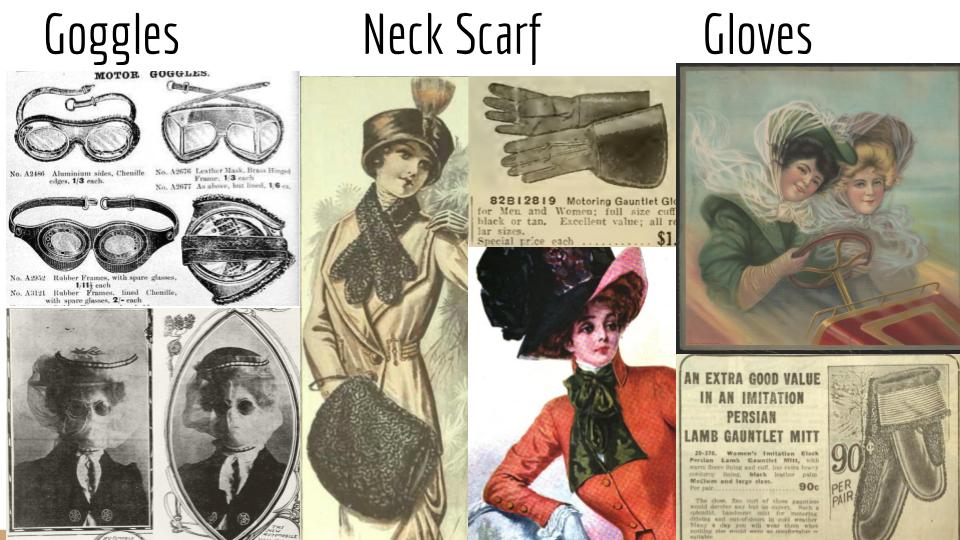
Some ladies recommended some additional items to have in your car:
- Additional change of clothes, shoes, gloves, jewelry, and accessories. Many women stopped on the side of the road just before entering their final destination to freshen up, remove jackets, change out dirty accessories, and put on more appropriate footwear. It may seem silly, but looking like a mud-monster while checking into a nice hotel after a long drive was not appropriate for a well-bred lady. Women received better treatment when they looked their finest.
- Extra “work” gloves, handkerchiefs, smock, a small blanket, and Antioyl soap were necessary for on the drive, very dirty repairs.
- A handheld mirror was used to see behind the car while driving.
- Makeup – a bit of powder was used to touch up a sun burned face. Face lotion to heal chapped and burned skin. Hair pins helped re-style fly-away hairs. Sucking on candy helped keep mouths from becoming too dry.
- Gun – Solo motorists may have carried to small colt gun in their side box or pocket “just in case.”
- Dog – Dogs love car rides and they make good companions on a long, solo road trip. Husbands are nice too.
- A small handbag may have been used to carry a few items into town. Otherwise, most motoring coats had very large pockets.
Your Motoring Outfit
Many women want to wear clothing that matches the year of their car. An excellent idea. Here are some things to consider.
First the year of your car is not where to start your research. It took 6 months to a year for wealthy women to first see a “new” style in an advertisement before they were handmade by a local seamstress or ordered from a top designer. Less wealthy women may have been a few years behind fashion trends. They also didn’t replace certain clothes (like coats) as often as hats. Begin your research with styles at least a year ahead of your car model but don’t be afraid to dip back a little earlier than that. Ask me for help if you need photos and illustrations of your year(s).
Once you decide what outfit you want, it’s time to start shopping or sewing. Your budget will determine what you can achieve.
- Thrift stores – I find a lot of great clothes in the thrift stores. Blouses, hats, belts, and shoes are the easiest to find. Coats, smocks, suit jackets, and skirts are usually harder if not impossible. These are best to buy to sew.
- Buying new “inspired” clothing – This is the bulk of the clothes I find and buy online (and what I link to on the website). New clothing with an Edwardian look is usually good enough for most outfits. Unlike antique clothing, they are usually washable too.
- Buying new “reproduction” clothing – These are “costumes” designed with original garments as inspiration, but adjusted to fit modern bodies not wearing proper undergarments. They can range from affordable to expensive. Always leave room for local alterations. A little nip and tuck goes a long way to transform an outfit from frumpy to perfection. Avoid cheap Halloween costumes.
- Sew your own or hire a seamstress to make your own outfit using Edwardian sewing patterns. This is not the cheapest option, but usually has the most historically accurate results. Be sure to buy the best fabrics (no polyester!).
- Hair and makeup is the final step to make your outfit the best it can be. Luckily, hats hide most hair, but a few hair pieces or a wig can go a long way to creating the voluminous Edwardian hairstyles.
Need help? Ask me anytime.
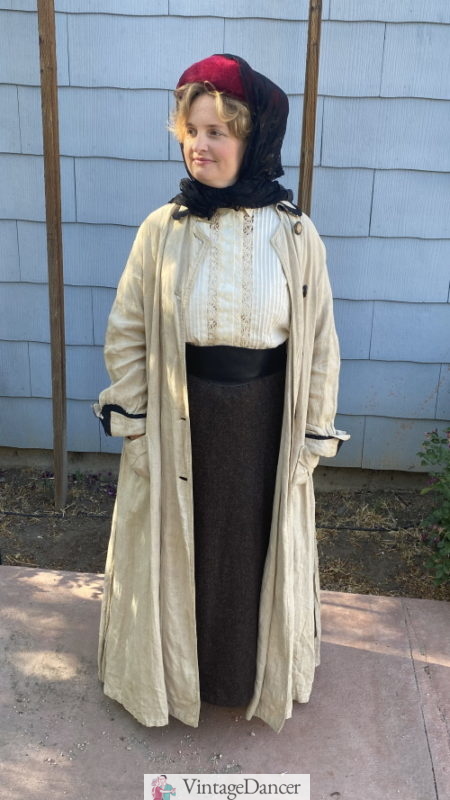
My Edwardian motoring outfit- All thrifted except the coat
Further research:
The Car magazine (London), Motor magazine (USA), American Motorist (USA) – Each has a section for women in each addition. Usually its about trendy fashions while not driving a car, but occasionally they discuss motoring clothes.
By Motor to the Golden Gate, by Emily Post, is a fun read about her travels by car from New York to San Francisco in 1915. She was a avid driver and passenger, having traveled all over Europe in the 1893 as well as the East Coast in the 1900s.
The Woman and the Car: A Chatty Little Handbook for all Women, by Dorothy Levitt. This book published in 1909 is the authors experience and advise about being a solo woman motorist. There are additional books written by women who traveled by car. All fun reads, although most do not discuss clothing.
Debbie Sessions has been teaching fashion history and helping people dress for vintage themed events since 2009. She has turned a hobby into VintageDancer.com with hundreds of well researched articles and hand picked links to vintage inspired clothing online. She aims to make dressing accurately (or not) an affordable option for all. Oh, and she dances too.
